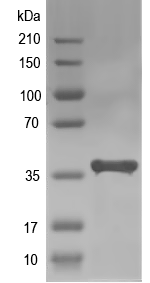Protein expression services for Kcnk1 | Potassium channel subfamily K member 1
Description
Ion channel that contributes to passive transmembrane potassium transport and to the regulation of the resting membrane potential in brain astrocytes, but also in kidney and in other tissues (PubMed:16847696, PubMed:22431633, PubMed:24368895). Forms dimeric channels through which potassium ions pass in accordance with their electrochemical gradient. The channel is selective for K(+) ions at physiological potassium concentrations and at neutral pH, but becomes permeable to Na(+) at subphysiological K(+) levels and upon acidification of the extracellular medium. The homodimer has very low potassium channel activity, when expressed in heterologous systems, and can function as weakly inward rectifying potassium channel (PubMed:9013852, PubMed:24496152). Channel activity is modulated by activation of serotonin receptors (PubMed:24368895). Heterodimeric channels containing KCNK1 and KCNK2 have much higher activity, and may represent the predominant form in astrocytes (PubMed:24496152). Heterodimeric channels containing KCNK1 and KCNK3 or KCNK9 have much higher activity. Heterodimeric channels formed by KCNK1 and KCNK9 may contribute to halothane-sensitive currents (By similarity). Mediates outward rectifying potassium currents in dentate gyrus granule cells and contributes to the regulation of their resting membrane potential (PubMed:25406588). Contributes to the regulation of action potential firing in dentate gyrus granule cells and down-regulates their intrinsic excitability (PubMed:25406588). In astrocytes, the heterodimer formed by KCNK1 and KCNK2 is required for rapid glutamate release in response to activation of G-protein coupled receptors, such as F2R and CNR1 (PubMed:24496152). Required for normal ion and water transport in the kidney (PubMed:16025300). Contributes to the regulation of the resting membrane potential of pancreatic beta cells (PubMed:22431633). The low channel activity of homodimeric KCNK1 may be due to sumoylation. The low channel activity may be due to rapid internalization from the cell membrane and retention in recycling endosomes (PubMed:15540117).
Family
Belongs to the two pore domain potassium channel (TC 1.A.1.8) family.
Species
Mus musculus
Length
336 amino acids
Sequence
MLQSLAGSSCVRLVERHRSAWCFGFLVLGYLLYLVFGAVVFSSVELPYEDLLRQELRKLKRRFLEEHECLSEPQLEQFLGRVLEASNYGVSVLSNASGNWNWDFTSALFFASTVLSTTGYGHTVPLSDGGKAFCIIYSVIGIPFTLLFLTAVVQRVTVHVTRRPVLYFHIRWGFSKQVVAIVHAVLLGFVTVSCFFFIPAAVFSVLEDDWNFLESFYFCFISLSTIGLGDYVPGEGYNQKFRELYKIGITCYLLLGLIAMLVVLETFCELHELKKFRKMFYVKKDKDEDLVHIMEHDQLSFSSVTEQVAGLKEEQKQSEPFVASQSPPYEDGSADH
Mass
38.2 kDa
Simulated SDS-PAGE
 (Note: Representative image - actual molecular weight may vary depending on tag type and expression method)
(Note: Representative image - actual molecular weight may vary depending on tag type and expression method)Safety
Upon ordering, we will perform rigorous biosecurity and export control screening to ensure that order fulfillment is consistent with all legal and regulatory guidance.
Protein synthesis service
Make Kcnk1 using our protein expression services starting at $99 + $.30/amino acid in as fast as two weeks (includes the cost of DNA synthesis)
Order Here